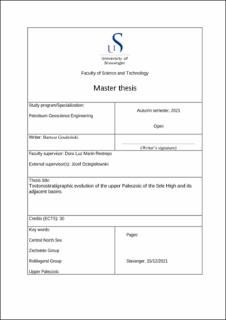| dc.description.abstract | The main focus of this study is to improve the understanding of the timing of the tectonic activity and its control over the distribution of the upper Paleozoic strata in the chosen study area. The study area is located approximately 150 km south-west from Stavanger and covers it includes Sele High and the northernmost part of the Danish-Norwegian basin, northernmost part of Jæren High and the entire Southeastern bank of Ling Depression. This thesis utilizes 2D and 3D seismic volumes to generate time surface maps of the top Zechstein, top Rotliegend and bottom Rotliegend horizons. As well as well log data and open-source Norwegian Petroleum Directorate well reports in order to study lateral and vertical facies variation of the Zechstein and Rotliegend Groups. In the study area The Zechstein Group assembles a variety of evaporitic and siliciclastic rocks. However, in the study area its succession consists mainly of halite except 8/3-1 well. The Rotliegend Group in the study area includes packages of siltstone, sandstone, and shales. Rotliegend is homogeneously distributed over the study area. The older Upper Paleozoic rocks were encountered only 7/3-1 well and 17/12-2. In the well 7/3-1 below the Rotliegend GP the carbonates were encountered. While the 17/12-2 well presents Devonian sandstone. However, since those two upper Paleozoic sections are barren of fossils, their exact age is uncertain. Based on the interpretation of the seismic images the three fault groups were distinguished from the subsequent strikes N-S, NE-SW, W-E. These fault groups appear to crosscut the Rotliegend without showing sign of syn-sedimentary deposition. However, in some of the interpreted cross-sections the thickening of pre-Rotliegend strata is visible along the N-S and NE-SW. Therefore the study area was subjected under two main extensional events: the Late Devonian-Early Carboniferous, late Permian to Early-Triassic. | |
